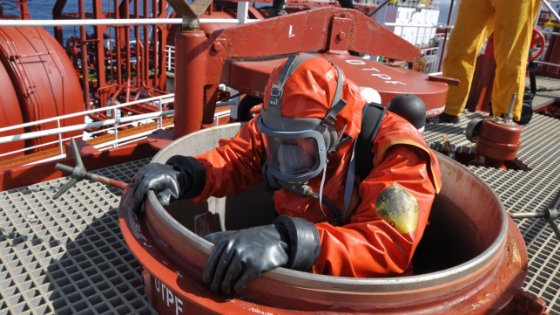Under regulation 29 CFR 1910.146, the Occupational Health and Safety Administration (OSHA) requires employees to be protected from hazards associated with entering confined spaces.
Permit Required: Confined Spaces
An area qualifies as a permit-required confined space (PRCS) if it:
- Is large enough for an employee to enter and work
- Has limited means of entry or exit
- Isn’t ideal or intended for extended occupancy, and
Contains at least one of the following:
- A substance that can potentially engulf or suffocate the person inside a potentially hazardous environment
- Walls the converge inward or a sloped floor that tapers to a small cross section
- Any other potential safety or health hazard
Typically, places like sewers, tanks, attics, closets, crawl spaces, and pits would constitute confined spaces, though you may encounter other examples on the job.
Key Requirements
The employer is responsible for evaluating the workplace to determine if any confined spaces qualify for a confined spaces permit. If the employer discovers confined spaces that require a permit, he or she is required to inform all exposed workers about the areas, as well as place signs to indicate each confined space and the dangers therein.
If employees are not allowed to enter these areas, employers should take measures to ensure restrictions are in place, as well as consequences for violating the restrictions. If employees are permitted to enter these areas, the employer must develop and implement a written permit policy that allows entry.
Note that this program may be evaluated and reviewed by employees and other authorized representatives.
OSHA expects the entry permit to list the following pieces of information, as detailed in paragraph (f) of the regulation:
- The space to be entered
- Reason for entry into the space
- Date and authorized duration of entry
- Those who have been authorized to enter
- Names of personnel serving as attendants to entry
- Name of entry supervisor, along with signature or initial of supervisor who originally authorized entry
- The hazards of the permit space
- The precautions used to isolate the space and to control space hazards prior to entry
- Acceptable entry conditions
- Results of initial and ongoing tests of the space, along with the signature or initials of the testers and when the tests were performed
- Available rescue and emergency services and how to summon them
- Communications procedures between entrants and attendants
- Any equipment to be used during entry, such as protective gear
- Any necessary information as applicable to the space, including additional required permits such as those for hot work
In addition, permit-required confined spaces must retain an entrance cover that should only be removed for entry and exit. If a hazard affects the safety of removing the entrance cover, you will need to eliminate the hazard before removing the cover.
You may need to enter the space before a confined-space permit can be developed in order to access the environment and determine if the area will qualify as a permit-required confined space. In this case, no such permit is needed during this initial entry.
Benefiting from these tips so far?
Download our Work Permits eBook for more best practices!
Confined Space Best Practices
As described in OSHA regulation 29 CFR 1910.146, employers must issue permits for entry into confined spaces. OSHA regulation 29 CFR 1926.1206 for confined spaces in construction bears a similar resemblance, but the difference is the need to monitor and detect changes in atmospheric hazard if the ventilation system were to fail. In the case of system failure, employees should be alerted immediately.
When stating the purpose of entering the space, you should be as descriptively succinct as possible. That is, you need enough detail to let others know your purpose, but you don’t need to tell an entire story. One example would be indicating you were “replacing communications cable in the sewer line,” as opposed to the vaguer “working in sewer line.”
You should also establish and implement a system that ensures all entrants have exited the confined space in case of an evacuation. Tracking the names of all entrants, as specified in the permit requirements above, can help in identification, but this does not help to track all entrants in the PRCS at all times.
When considering options for keeping track of the current occupancy of the PRCS at any given time, it’s important to include the name of each individual. This information might help pinpoint where each worker may be physically in the PRCS if rescue crews were needed.
How to Remain OSHA Compliant
To remain in compliance with OSHA regulation 29 CFR 1926.1206, employers must identify confined spaces by placing an entry permit outside the entrance to demonstrate the employer’s effort in identifying and controlling the area. The permit will need to contain the following information:
- The space to be entered to ensure employees use the correct permit for the correct space
- The reason for entry into the space
- The authorized date and duration of the entry permit
- The names or other identifiers of authorized entrants, as long as the attendant can quickly determine which entrants are authorized in the space
- Means of detecting a rise in hazardous atmospheric levels if the ventilation system were to quit
- The name of the entry supervisor, and the signature or initials of every supervisor who authorized previous entry
For a complete listing of requirements and specifications for this regulation, please visit www.osha.gov.
